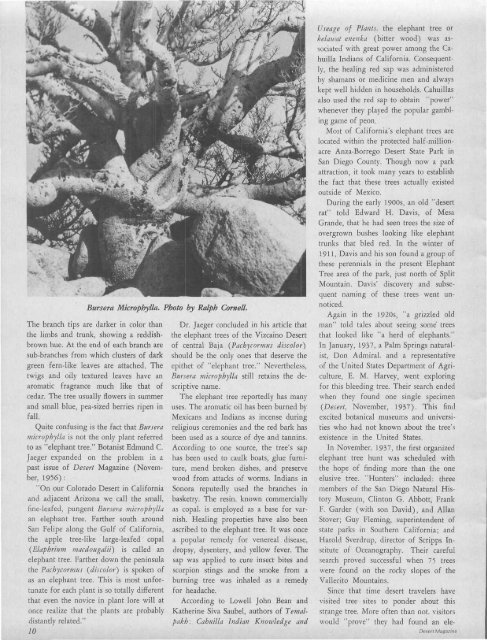Desert Magazine Book Shop - Desert Magazine of the Southwest
Desert Magazine Book Shop - Desert Magazine of the Southwest
Desert Magazine Book Shop - Desert Magazine of the Southwest
Create successful ePaper yourself
Turn your PDF publications into a flip-book with our unique Google optimized e-Paper software.
Bursera Microphylla. Photo by Ralph Cornell.<br />
The branch tips are darker in color than<br />
<strong>the</strong> limbs and trunk, showing a reddishbrown<br />
hue. At <strong>the</strong> end <strong>of</strong> each branch are<br />
sub-branches from which clusters <strong>of</strong> dark<br />
green fern-like leaves are attached. The<br />
twigs and oily textured leaves have an<br />
aromatic fragrance much like that <strong>of</strong><br />
cedar. The tree usually flowers in summer<br />
and small blue, pea-sized berries ripen in<br />
fall.<br />
Quite confusing is <strong>the</strong> fact that Bursera<br />
microphylla is not <strong>the</strong> only plant referred<br />
to as "elephant tree." Botanist Edmund C.<br />
Jaeger expanded on <strong>the</strong> problem in a<br />
past issue <strong>of</strong> <strong>Desert</strong> <strong>Magazine</strong> (November,<br />
1956):<br />
"On our Colorado <strong>Desert</strong> in California<br />
and adjacent Arizona we call <strong>the</strong> small,<br />
fine-leafed, pungent Bursera microphylla<br />
an elephant tree. Far<strong>the</strong>r south around<br />
San Felipe along <strong>the</strong> Gulf <strong>of</strong> California,<br />
<strong>the</strong> apple tree-like large-leafed copal<br />
(Elaphrium macdougalii) is called an<br />
elephant tree. Far<strong>the</strong>r down <strong>the</strong> peninsula<br />
<strong>the</strong> Pachycormus {discolor) is spoken <strong>of</strong><br />
as an elephant tree. This is most unfortunate<br />
for each plant is so totally different<br />
that even <strong>the</strong> novice in plant lore will at<br />
once realize that <strong>the</strong> plants are probably<br />
distantly related."<br />
10<br />
Dr. Jaeger concluded in his article that<br />
<strong>the</strong> elephant trees <strong>of</strong> <strong>the</strong> Vizcaino <strong>Desert</strong><br />
<strong>of</strong> central Baja (Pachycormus discolor)<br />
should be <strong>the</strong> only ones that deserve <strong>the</strong><br />
epi<strong>the</strong>t <strong>of</strong> "elephant tree." Never<strong>the</strong>less,<br />
Bursera microphylla still retains <strong>the</strong> descriptive<br />
name.<br />
The elephant tree reportedly has many<br />
uses. The aromatic oil has been burned by<br />
Mexicans and Indians as incense during<br />
religious ceremonies and <strong>the</strong> red bark has<br />
been used as a source <strong>of</strong> dye and tannins.<br />
According to one source, <strong>the</strong> tree's sap<br />
has been used to caulk boats, glue furniture,<br />
mend broken dishes, and preserve<br />
wood from attacks <strong>of</strong> worms. Indians in<br />
Sonora reputedly used <strong>the</strong> branches in<br />
basketry. The resin, known commercially<br />
as copal, is employed as a base for varnish.<br />
Healing properties have also been<br />
ascribed to <strong>the</strong> elephant tree. It was once<br />
a popular remedy for venereal disease,<br />
dropsy, dysentery, and yellow fever. The<br />
sap was applied to cure insect bites and<br />
scorpion stings and <strong>the</strong> smoke from a<br />
burning tree was inhaled as a remedy<br />
for headache.<br />
According to Lowell John Bean and<br />
Ka<strong>the</strong>rine Siva Saubel, authors <strong>of</strong> Temalpakh:<br />
Cahuilla Indian Knowledge and<br />
Useage <strong>of</strong> Plants, <strong>the</strong> elephant tree or<br />
kelawat enenka (bitter wood) was associated"<br />
with great power among <strong>the</strong> Cahuilla<br />
Indians <strong>of</strong> California. Consequently,<br />
<strong>the</strong> healing red sap was administered<br />
by shamans or medicine men and always<br />
kept well hidden in households. Cahuillas<br />
also used <strong>the</strong> red sap to obtain "power"<br />
whenever <strong>the</strong>y played <strong>the</strong> popular gambling<br />
game <strong>of</strong> peon.<br />
Most <strong>of</strong> California's elephant trees are<br />
located within <strong>the</strong> protected half-millionacre<br />
Anza-Borrego <strong>Desert</strong> State Park in<br />
San Diego County. Though now a park<br />
attraction, it took many years to establish<br />
<strong>the</strong> fact that <strong>the</strong>se trees actually existed<br />
outside <strong>of</strong> Mexico.<br />
During <strong>the</strong> early 1900s, an old "desert<br />
rat" told Edward H. Davis, <strong>of</strong> Mesa<br />
Grande, that he had seen trees <strong>the</strong> size <strong>of</strong><br />
overgrown bushes looking like elephant<br />
trunks that bled red. In <strong>the</strong> winter <strong>of</strong><br />
1911, Davis and his son found a group <strong>of</strong><br />
<strong>the</strong>se perennials in <strong>the</strong> present Elephant<br />
Tree area <strong>of</strong> <strong>the</strong> park, just north <strong>of</strong> Split<br />
Mountain. Davis' discovery and subsequent<br />
naming <strong>of</strong> <strong>the</strong>se trees went unnoticed.<br />
Again in <strong>the</strong> 1920s, "a grizzled old<br />
man" told tales about seeing some' trees<br />
that looked like "a herd <strong>of</strong> elephants."<br />
In January, 1937, a Palm Springs naturalist,<br />
Don Admiral, and a representative<br />
<strong>of</strong> <strong>the</strong> United States Department <strong>of</strong> Agriculture,<br />
E. M. Harvey, went exploring<br />
for this bleeding tree. Their search ended<br />
when <strong>the</strong>y found one single specimen<br />
(<strong>Desert</strong>, November, 1937). This find<br />
excited botanical museums and universities<br />
who had not known about <strong>the</strong> tree's<br />
existence in <strong>the</strong> United States.<br />
In November, 1937, <strong>the</strong> first organized<br />
elephant tree hunt was scheduled with<br />
<strong>the</strong> hope <strong>of</strong> finding more than <strong>the</strong> one<br />
elusive tree. "Hunters" included: three<br />
members <strong>of</strong> <strong>the</strong> San Diego Natural History<br />
Museum, Clinton G. Abbott, Frank<br />
F. Garder (with son David), and Allan<br />
Stover; Guy Fleming, superintendent <strong>of</strong><br />
state parks in Sou<strong>the</strong>rn California; and<br />
Harold Sverdrup, director <strong>of</strong> Scripps Institute<br />
<strong>of</strong> Oceanography. Their careful<br />
search proved successful when 75 trees<br />
were found on <strong>the</strong> rocky slopes <strong>of</strong> <strong>the</strong><br />
Vallecito Mountains.<br />
Since that time desert travelers have<br />
visited tree sites to ponder about this<br />
strange tree. More <strong>of</strong>ten than not, visitors<br />
would "prove" <strong>the</strong>y had found an ele-<br />
Deserr <strong>Magazine</strong>

















